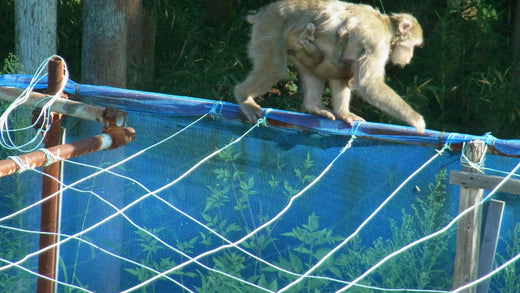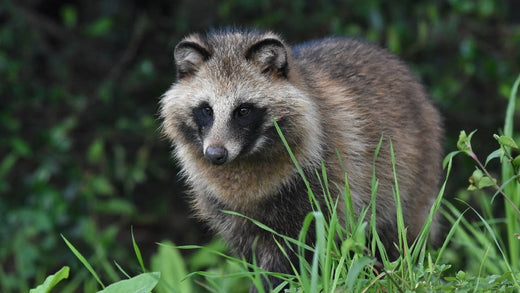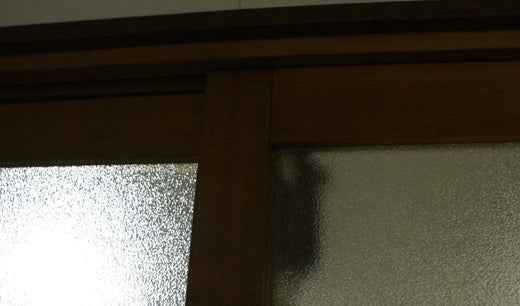Among crop damage caused by wild birds and animals, the damage caused by monkeys is the second largest after wild boars and deer.
In recent years, the annual damage amount is about 860 million yen, which is about one-fifth of the damage caused by wild boars.
In addition, because of their high learning ability, they learn the taste of various agricultural products in the region, so there is a tendency for the target crops to be damaged.
However, there are cases in which the damage caused by monkeys has been almost completely resolved, and it can be said that if you know the monkeys well and take appropriate measures, the damage can definitely be suppressed. In this article, we will discuss the ecology of monkeys and how to control, trap, and exterminate them.
Ecology of Japanese macaques
First, let's look at the ecology as basic information for taking measures against Japanese macaques.
Japanese macaques are widely distributed in Honshu, Shikoku, and Kyushu, excluding Hokkaido. In general, primates (gorillas, orangutans, etc.) inhabit tropical and temperate jungles, but Japanese macaques inhabit areas where snow can be seen, such as the Tohoku region. In Japan, Aomori Prefecture is considered to be the northern limit, and it has a rare habit that its distribution is confirmed nationwide.
Males are 50 to 60 cm long, females are 45 to 55 cm long, and their fur is dark reddish brown. It has no hair on its face and is reddish.
diet
Plant foods such as leaves, seeds, fruits and sprouts of plants are the main. It is omnivorous and eats insects, but basically does not eat meat or fish (it does not mean that it does not eat at all, and there have been reports of it eating fish and shellfish and preying on the chicks of ptarmigans).
Also, avoid plants that have a strong pungent taste, smell, or bitterness, such as pepper, konnyaku, perilla, burdock, ginger, and bracken. Her favorite food is easy-to-eat crops with high sugar content and nutritional value (oysters, watermelons, pumpkins, sweet potatoes, peaches, chestnuts, corn, etc.).
Even among those crops, they eat only the delicious parts and throw them away, and eat new crops one after another, so leftovers are scattered in the damaged areas.
The food they eat is not genetically determined, and is said to be learned after birth. Therefore, if they can learn the taste of other crops, they will target those crops and act accordingly, expanding the types of damaged crops.
learning ability and physical ability
It is well known that it has a high learning ability, such as washing sweet potatoes with water and eating them, and learning tricks, but it is especially good at memory.
It quickly learns places where it finds delicious food, places it learns are dangerous, and even people's faces. In addition, there is no behavior that monkeys cooperate with each other to work.
The sense of smell and hearing of Japanese macaques is about the same as that of humans, and inferior to that of wild boars, which have a dog-like sense of smell, and deer, which have a keen sense of hearing. It gathers most of its information visually and is active during the day.
They are good at climbing trees and jumping, and can climb walls and pillars with a few millimeters of leverage, so they can easily climb over fences set up for wild boars and deer.
breeding and behavior
In wild herds, it is said that they experience their first birth at the age of 6 to 7 years, and then give birth once every 2 to 3 years. Compared to deer, which give birth almost every year, and wild boars, which are prolific, their reproductive power is not strong.
However, if the nutritional status is improved by crops and feeding, the age at first birth may be earlier and the birth interval may be shortened. They generally move in groups and have a fixed range of action. Herds consist of about 10 to 100 animals, mainly consisting of females and cubs. Female monkeys spend their entire lives in the same group.
When males reach maturity, they leave the group and enter another group, or live as detached monkeys. Although it depends on the region, when the number of individuals in a herd exceeds about 60, the herd will naturally split, and in many cases one of the herds will move to adjacent areas.
Current Status of Crop Damage by Monkeys
So what is the current state of crop damage caused by monkeys?

Source: Ministry of Agriculture, Forestry and Fisheries website
According to a survey by the Ministry of Agriculture, Forestry and Fisheries, the amount of damage to crops in FY2019 was about 860 million yen. It has decreased by about 4.3% compared to the previous year, and even if you look at the data for the last 20 years, the amount of damage has been decreasing year by year.
However, monkeys have a habit of moving in groups. Therefore, once crop damage occurs, it tends to concentrate in one place, causing serious damage locally. The high degree of difficulty in taking countermeasures due to the habit of living in trees is one of the reasons for the spread of damage.
Damage to homes and casualties has also occurred.
In recent years, monkeys have become accustomed to people. Monkeys often appear in residential areas and are often featured in the news, but year by year the monkey habitat tends to expand into human living areas. One reason for this is the abundance of highly nutritious food, but another reason is that the monkeys have become accustomed to humans.
Compared to other beasts, monkeys adapt quickly to their living environment and get used to people and homes quickly. Since the roofs of buildings and electric wires are used as routes of movement, there is also damage to houses. Also, during mating season, monkeys become aggressive and may threaten or attack humans. Residents and children on the way to school may suffer human damage such as being bitten or scratched, so vigilance is required.
Preventive measures, capture, and extermination considering the ecology of monkeys
As can be said for any animal damage control, environmental maintenance is the basis. Monkeys come to settlements because they perceive the settlements to be rich in nutritious food and to pose little danger or threat.
First of all, even if it is a small number of people, create a group for animal damage countermeasures and work to expand the circle of the group. In addition, in order to prevent monkeys from turning human villages into feeding grounds, we will strictly prohibit feeding, remove abandoned fruit trees, abandoned agricultural products, and raw garbage, and temporarily pay for bushes to reduce places where animals can hide.
If abandoned farmland is left as it is, the monkeys that have learned to taste it will start moving into the surrounding fields. Persimmon and chestnut trees, which monkeys like to eat, should be cut down if they are no longer in use.
To improve the environment, it is also important to reduce the places where animals hide. Mow bushes, trees and branches to reduce the number of hiding places for monkeys. If you cut down trees near your residence, you will not be able to get close to your residence through the top of the tree, so the control effect will increase. Likewise, if possible, remove any unused barns, sheds, etc., as hiding places. It is important to create an environment with good visibility.
In addition, it is effective to implement control measures that take into account the ecology of monkeys.
Reference article: Types of animal damage and countermeasures
Thorough 'expulsion'
The process of driving out monkeys that have appeared in farmlands and villages by various means is called 'expulsion'. The purpose is to use the monkey's learning ability to learn that farmlands and villages are dangerous places, and to make them settle outside of human living areas.
An important point in chasing away monkeys is to always chase them away when they appear, and not to cut corners even on one. Half-hearted chasing makes people perceive that they are not scary, so on the contrary, they get accustomed to people.
When they become less wary of humans, they become more daring in their behavior, such as intimidating them and destroying human living areas.
In particular, after harvesting crops, it is easy to loosen your hand on chasing them away. If the monkey gets accustomed to the environment in the meantime, the damage will spread during the next habit.
Therefore, it is a good idea to prepare an effective method of expulsion that can be implemented by anyone in the area. Typical methods include rocket fireworks, firecrackers, electric guns (airguns), slingshots (slingshots), and chased away by trained dogs (monkey dogs).
There are many cases of damage such as being attacked by angry monkeys when chasing them away. If children or elderly people are driving away, it is safe to build a system to cooperate with the community or group.
In addition, chasing may cause monkeys to escape by climbing tall trees in villages. Monkeys know that humans cannot climb trees. In addition to cutting down trees, it is a good idea to devise ways to make it difficult for monkeys to climb.
* Fireworks have a flight distance of several tens of meters, so be careful of fires in areas with a lot of dry grass or in dry weather.
Installation of guard fences for monkeys
Protective fences are the final line to prevent intrusion into farmland. Since monkeys climb over ordinary protective fences, it is necessary to install fences that are compatible with monkeys.
Considering the behavior of monkeys, there are various types of nets, such as a type that gives an electric shock when it grabs a pole, and a type that is easy to get electrocuted because it takes time to climb up because the net is far from the pole. In addition to this, it is also possible to devise ways to prevent the monkeys from touching the fence with barbed iron plates, or to restrict the areas where the monkeys touch the fences so that they can be electrocuted efficiently.
In addition, using glass poles with soft fence stakes creates an environment that makes it difficult for monkeys to climb, increasing the control effect.
However, it is important to maintain the protective fence properly, not the end once it is installed. In particular, if there is a problem with the electric system, the electric fence will not be effective, and there is also the risk of accidents, so be careful.
When installing an electric fence, do not turn on the electricity after all the fences are installed, but turn on the electricity in order from the part where the installation is finished. If you touch the fence before turning on the electricity, the monkeys will feel relieved and the control effect will be reduced. Let's work hard not to show the monkey a gap.
Measures to prevent damage caused by capture
If the above measures do not reduce the damage caused by the monkeys, or if human casualties occur, the monkeys causing the damage will be captured. *Japanese macaques are not hunting birds and beasts. Permission based on the "Law Concerning the Protection, Management and Proper Hunting of Wildlife" is required when capturing (harmful wildlife capture).
First of all, it is important to observe and identify groups of monkeys that are the cause of damage and isolated monkeys, and to make a plan to capture them efficiently.
Box traps are mainly used for trapping. A box trap is a box-shaped cage that is used to capture wild animals. Bait is used to attract prey into the box, and when the prey enters the box, the door falls down and the trap is complete! That's how it works.
First of all, induce the door in a state where it does not fall down, and give it a break-in period. Once the monkey is sufficiently accustomed to the trap that it can go all the way into the box trap, it can be captured with the door ready for it to fall.
Pumpkins and sweet potatoes, which monkeys like, are used as food. The bait placed around the box trap for lure should be less fresh or less fresh. By doing this, monkeys seeking fresher and tastier food can be guided inside the trap.
If the mesh of the cage is large, the monkeys will stick their hands in from the outside of the trap to get food and will not be able to enter the trap. It is also a good idea to place the bait in the center of the trap, out of reach of the monkeys. In the case of box traps, it is not possible to select the sex or age of the monkeys to be captured, as they are lured by bait.
If the herd is split up by capture, there is a risk that the damage will spread in return, so females who have a lot of experience giving birth in herds that are likely to split up (well-built and large, with long nipples on the left and right) are captured, release them as much as possible to prevent fragmentation.
In addition, since Japanese macaques may carry the virus, do not touch them with bare hands to avoid being bitten or getting blood droplets into the mucous membranes of the eyes and mouth. Be careful not to touch it. It is safe to wear protective gloves (animal capture gloves) for capture work .
See also this article >>How to choose a cage (box trap) for wild boars, etc.

 箱罠
箱罠
 くくり罠
くくり罠
 パーツ類
パーツ類
 電気柵
電気柵
 自作キット
自作キット
 防獣グッズ
防獣グッズ
 監視カメラ
監視カメラ










 box trap
box trap
 tying trap
tying trap
 enclosure trap
enclosure trap
 Prevention and avoidance goods
Prevention and avoidance goods
 electric fence
electric fence
 trap surveillance camera
trap surveillance camera
 transportation goods
transportation goods
 Trap detection sensor
Trap detection sensor
 hunting supplies
hunting supplies
 hunting books
hunting books
 Anti-bird goods
Anti-bird goods
 Agricultural materials/machinery
Agricultural materials/machinery
 boar
boar
 deer
deer
 Kyon
Kyon
 monkey
monkey
 raccoon
raccoon
 Badger
Badger
 palm civet
palm civet
 raccoon dog
raccoon dog
 nutria
nutria
 mouse or rat
mouse or rat
 Mole
Mole
 bear
bear
 pigeon
pigeon
 Crow
Crow







